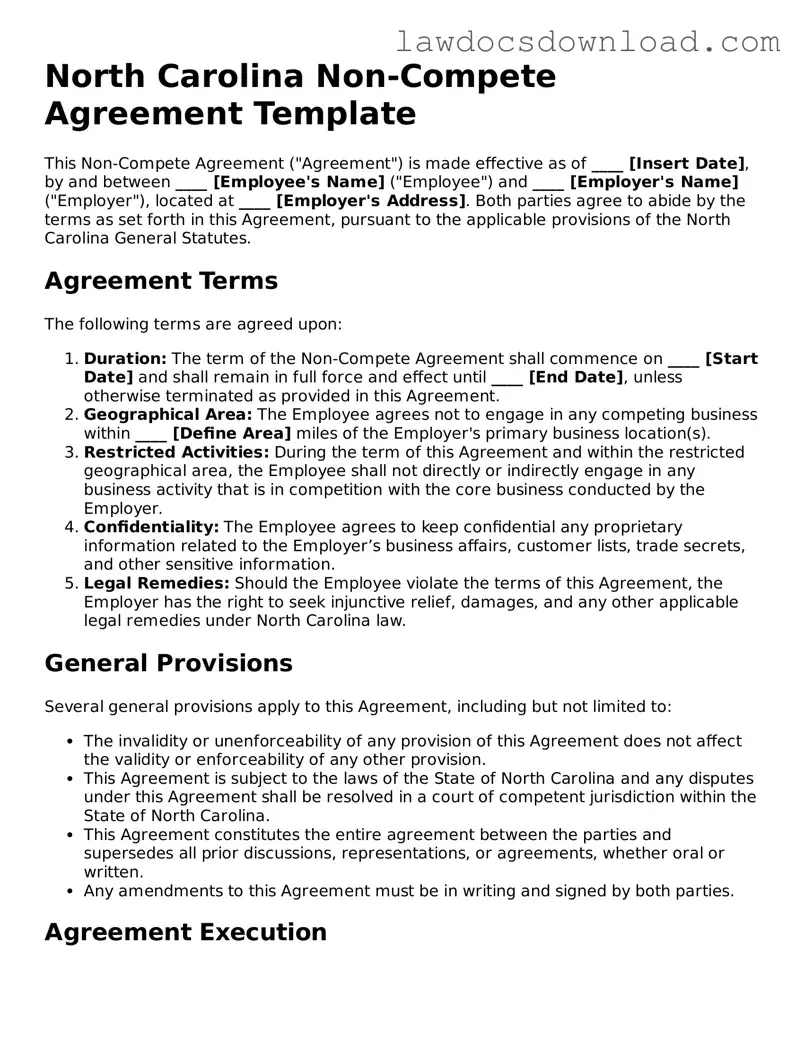The Non-Disclosure Agreement (NDA) closely relates to the Non-compete Agreement, as both forms are dedicated to protecting sensitive information and business interests. An NDA specifically restricts the sharing of confidential information, ensuring that secrets such as formulas, client lists, or business strategies do not leave the confines of the workplace. Similar to non-compete agreements, NDAs are built on the premise of safeguarding a company's competitive edge, albeit through a more focused lens on information confidentiality.
An Employment Agreement often includes clauses that mirror the protective nature of a Non-compete Agreement, especially in terms of an employee's responsibilities and restrictions both during and after employment. Whereas a Non-compete Agreement specifically restricts working in competing businesses post-employment, an Employment Agreement outlines the broader terms of the employment relationship, including duties, compensation, and grounds for termination. These agreements sometimes encompass non-compete clauses to ensure the company's market position is not compromised by the future actions of former employees.
The Independent Contractor Agreement, like the Non-compete Agreement, governs the terms of service between a contractor and a company, but with a focus on project-based or temporary relationships. It may include terms similar to those found in non-compete agreements, such as clauses that prevent the contractor from engaging with direct competitors for a specified period after completing their work. This agreement ensures that the contractor's knowledge of the company's internal workings or strategic plans does not become a competitive liability.
Intellectual Property (IP) Assignment Agreements share the Non-compete Agreement's goal of protecting valuable business assets. However, IP assignments specifically transfer ownership of innovations, creations, or discoveries from an individual to a company. This legal document ensures that anything developed by an employee during their tenure—be it inventions, writings, or software—legally belongs to the employer, preventing the potential spread of proprietary assets to competitors.
The Confidentiality Agreement, similar to an NDA and often intertwined with Non-compete Agreements, focuses exclusively on ensuring that any shared information between parties remains private. It is commonly used during negotiations, partnerships, or when accessing special projects to secure a mutual understanding that sensitive information will not be disclosed. Though its scope is specific, this agreement complements a non-compete by fostering an environment of trust and protection of business operations.
Non-solicitation Agreements are often mentioned in tandem with Non-compete Agreements as they help protect a company's most valuable resources: its employees and customers. These agreements restrict departing employees from poaching clients, customers, or fellow employees after leaving the company. While non-compete agreements limit where one can work post-employment, non-solicitation agreements specify who the departing employee cannot interact with professionally, thus safeguarding the company's internal and external relationships.
The Partner Agreement is essential for businesses operated by more than one individual, laying down the ownership percentages, roles, and responsibilities of each partner. Similar to a Non-compete Agreement, it can contain clauses that limit a partner's ability to start or join competing businesses, ensuring that the partnership's interests are protected and reducing the risk of internal conflicts compromising the business's integrity. This document helps maintain a fair and competitive balance within the business landscape.
Lastly, the Severance Agreement, typically offered to employees at the end of their employment, can contain elements reminiscent of a Non-compete Agreement. While primarily designed to provide former employees with financial benefits or compensation packages, severance agreements can also include clauses that prohibit the employee from competing with the business for a certain period post-termination. This ensures that the separation is mutually beneficial and that the company's competitive standing remains secure even after the employee's departure.
